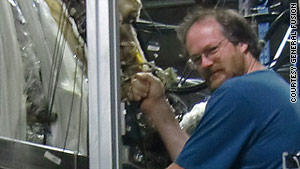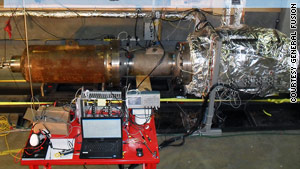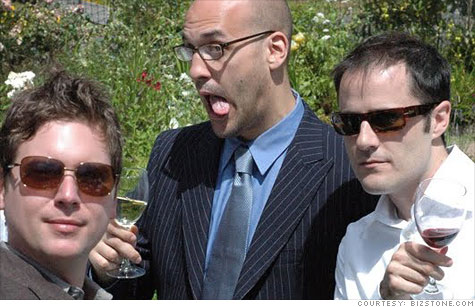I love this video
Check it!
This is Arlette's Blog
26 julio, 2011
Free Software
Hello again my followers :3
Today I bring my presentation on free software.
Take a look and tell me so.
My presentation is on Units 1, 3 and 4.
I hope they enjoy it :D
Today I bring my presentation on free software.
Take a look and tell me so.
My presentation is on Units 1, 3 and 4.
I hope they enjoy it :D
Etiquetas:
efl center,
english,
final proyect,
free software,
h312,
n311,
URBE
29 junio, 2011
Can one idea be energy's holy grail?
(CNN) -- Michel Laberge quit his job to invent a "glorified jackhammer" that he hoped would save the planet. That was 10 years ago.
Now, investors are betting more than $30 million on that jackhammer idea, which may yield a holy grail of energy -- a safe, clean and unlimited power source called hot fusion.
Laberge is trying to do something that no one has ever done: create a controlled "net gain" fusion reaction that creates more energy than is required to produce it. It's the same process that powers our sun. If it works, it could solve huge problems like climate change, the energy crunch and reliance on foreign oil.
But the competition to get there first is stiff. Thousands of scientists backed by the world's most powerful governments are racing against Laberge and his 50 colleagues working at an office park lab near Vancouver, British Columbia.
"This is a bit crazy -- the small guy trying to win the same thing as the big guys," admits the 49-year-old physicist. Some observers in the physics community wonder if upstarts like Laberge are being strangled by giant multibillion-dollar research projects.
Laberge says he's never wanted to rub shoulders with the cool kids at top-shelf facilities at Oak Ridge, Tennessee, and Livermore, California. "It's very boring to work on the big projects," says Laberge. They're "too big, too expensive, too complicated."
But don't call him a rebel. "I like to do some things differently," Laberge says. "I'm nonconventional, but I'm not a rebel."
He fears the next generation, including his own two children, are threatened by a world that's running out of fuel. "If we don't do something about energy we're going to be living in little huts with windmills on top," says Laberge. "For food, you're going to be growing tomatoes on the backside."

"I like to do some things differently, I'm nonconventional, but I'm not a rebel," says fusion energy pioneer Michel Laberge.
A decade ago, it was Laberge's self-described mid-life crisis that brought him to a career crossroads. Despite success designing technology for printing direct mail materials, he remained unsatisfied. "I was cutting the forest and burying you under junk mail," he remembers. "I said, 'What am I doing here?'"
Laberge took a chance and left Creo to chase his longtime fascination with fusion.
"I had fusion on the brain," he recalls.
"I sat at home on my couch for about six months, to the great despair of my wife, calculating all sorts of fusion schemes." Eventually, Laberge had his "aha" moment: a precision controlled piston that hammers giant shock waves into a magnetized sphere -- slamming atoms together hard enough to fuse and create energy.
The idea triggered investments in Laberge's young company, first from family and friends, then from venture capitalists including Amazon.com founder Jeff Bezos. So far, funding has totaled $32.5 million.
That sounds like a lot until you consider that the world's biggest fusion research facility -- under construction in France -- is expected to cost $20 billion. That's billion with a "b."
Named ITER -- the Latin word for "journey" -- the project is funded and staffed by the United States, European Union and five other nations.

Laberge designed this giant piston -- or "glorified jackhammer" -- as part of a planned fusion reactor.
China announced in May it will train 2,000 scientists for fusion research. Beijing "is going gung ho on this," says Glen Wurden, a top fusion scientist at the cradle of the atom bomb: New Mexico's Los Alamos National Laboratory. The facility has joined Laberge's company, General Fusion, in a cooperative research agreement.
Does Laberge have a shot? His idea is "definitely worth studying," Wurden says.
Even Ned Sauthoff, ITER's U.S. project manager, is cheering for smaller fusion researchers.
"I would love to see that fusion can be done so economically, and so I hope they succeed," Sauthoff says. "ITER is the way that you go if you really want high confidence. But you have to pay more for high confidence."
The ITER facility won't be complete until 2017. Best case, ITER's first net gain fusion reaction would take place sometime after 2019.
Another giant fusion project, the National Ignition Facility at California's Lawrence Livermore Laboratory, is using the world's largest lasers to attempt a fusion breakthrough by 2012 at a cost of about $5 billion.
"ITER and NIF are expensive and they take lots of energy," says Wurden. "We think there is a cheaper solution between the two."
"Basically, glorified jackhammers are cheaper than lasers," Laberge says with a laugh.
General Fusion aims to achieve net gain fusion experimentally in 2012. By 2018, it plans to complete a power plant prototype that would generate 100 megawatts, enough to power about 100,000 homes.
"We would like to be in a commercial stage of being able to take orders and build power plants by the end of the decade," said Michael Delage, General Fusion VP of business development.
Fusion could change everything -- or not
Could fusion change the way powerful governments behave on the world stage?
Cutting dependence on foreign oil could prompt nations to shift attention away from oil-rich regions. The U.S. military already spends at least $50 billion yearly on "expenditures related to oil," according to the American Security Project, a bipartisan Washington think tank.
The fuel for fusion reactors is relatively cheap and accessible. Fusion reactors would run on fuel made up of two types of hydrogen: deuterium, which can be extracted from sea water, and tritium, which could be produced by the fusion reactors themselves.
"I was cutting the forest and burying you under junk mail. I said, 'What am I doing here?'"
--Physicist Michel Laberge
--Physicist Michel Laberge
If fusion sounds familiar it's because science has been promising it for decades.
A historic fusion breakthrough is "really close," Wurden says, but developing a successful commercial fusion power plant is further off.
"So, if somebody tells you they're going to solve global warming with nuclear fusion three years from now just laugh them out of the street. OK? It's not going to happen."
"Fusion physicists are probably some of the worst people in the world at predicting the future in terms of how easy it's going to be for the next step," says Mike Dunne, Livermore's program director of laser fusion energy.
Fusion differs from conventional nuclear power because it makes energy by smashing atoms together to create new atoms instead of splitting them apart.
This year, Japan's nuclear plant crisis after an earthquake and tsunami showed the hazards posed by deadly radioactive fuel rods, which eventually must be disposed of safely.
In fusion, there is no threat of a meltdown and no waste from the fuel. Although the reactor and its components will become radioactive after years of exposure to the process, this radioactivity disappears after a few decades. Conventional nuclear fuel rods need thousands of years to lose radioactivity.
But anti-nuclear groups have expressed concern about whether fusion research opens a door to nuclear weapons proliferation. Tritium can be used to boost the power of nuclear weapons. Fusion research, they say, could contribute to development of a so-called pure fusion weapon.
"The government did look at this in some detail," said Dunne, who added that there are always fringe groups who are suspicious of "nefarious activities" when it comes to nuclear research.
Washington is comfortable that this technology provides no opportunities "for nuclear proliferation or advancement of other country's weapons capability," said Dunne. The development of commercial fusion, he says, has no defense applications.
Giant sucking sound?
The current budget-slashing climate on Capitol Hill doesn't bode well for fusion research. The 2012 federal budget is expected to provide about $400 million total.
But now that Congress is taking a hard look at budget cuts, lawmakers want more than ever to see encouraging results. The pressure is on to either produce results or re-think spending priorities.
With less research money available, will high-profile projects like ITER and NIF snatch government money from smaller private firms like Laberge's?
If somebody tells you they're going to solve global warming three years from now just laugh them out of the street.
--Glen Wurden, Los Alamos National Laboratory
--Glen Wurden, Los Alamos National Laboratory
An intensified scramble for cash could hurt other small players, such as Seattle-based Helion Energy and a secretive outfit with ties to the University of California called TriAlpha Energy.
"I hope that ITER and NIF -- these two giant elephants in the room -- won't absorb all the resources in the world just to do fusion a particular way," says Wurden.
Whatever the case, China and India's huge populations will need more and more energy each year and climatologists fear the worst from continued reliance on fossil fuels.
"We're burning the candle at both ends," Laberge says. "The standard of living is increasing rapidly due to technology and we're burning resources faster than they're being replenished. Sooner or later it's all going to come crashing down."
If that scenario comes to pass, will science be ready to tackle the challenge?
Etiquetas:
efl center,
english,
h312,
holy grail,
n311,
URBE
28 junio, 2011
Twitter co-founders to launch new startup

NEW YORK (CNNMoney) -- Three of Twitter's key developers-- Biz Stone, Evan Williams and Jason Goldman -- are launching a new venture.
The move is the latest musical-chairs shuffle at Twitter, which is undergoing a leadership overhaul as the five-year-old venture matures from a startup to a tech industry power player."Our plan is to develop new projects and work on solving big problems aligned along a simple mission statement: The Obvious Corporation develops systems that help people work together to improve the world," Stone wrote Tuesday in a blog post announcing their plans.
In October, COO Dick Costolo took over Evan Williams' role as the company's CEO, while Williams went off to focus on product development. But Williams soon after stepped back from day-to-day involvement at Twitter, while estranged co-founder Jack Dorsey -- now CEO of Square, another much-buzzed-about-startup -- returned to lead product development.
Stone was one of Twitter's most visible leaders, thanks to the personally written dispatches about Twitter's growth -- signed @biz -- that he sent out to users in the site's early days.
"The Twitter crew and its leadership team have grown incredibly productive," Stone wrote Tuesday in his blog post. "I've decided that the most effective use of my time is to get out of the way until I'm called upon to be of some specific use."
Together with Goldman -- a longtime collaborator with Stone and Williams who became one of Twitter's earliest employees -- the pair plans to focus their efforts on Obvious.
Goldman left his full-time position with Twitter in December, though he stayed involved as an advisor to the company. Williams also faded away from the company this year, though he emphasized that he will always play some role in Twitter's evolution.
"All three of us remain involved with Twitter and we are deeply invested in the company's long term success," the trio wrote on their Obvious.com website.
Obvious is actually a resurrection of a venture created in 2006. Williams created it to repurchase the assets of a failed venture of his, a podcasting site called Odeo. The Odeo crew had also cooked up Twitter.com as a side project -- and that's where their attention soon turned. Twitter later spun out from Obvious.
Obvious will be an umbrella for whatever new ventures its founders wish to pursue. The site, which went live Tuesday, lays out an ambitious vision: "In more than a decade of developing large scale systems on the Internet, we've never been more excited than right now."
But Williams also offered up a dry quip about the site's larval nature.
"Just (re)launched a new web site. It doesn't do much yet," he tweeted.
Lyric the "Life for rent"...
I haven't ever really found a place that I call home
I never stick around quite long enough to make it
I apologize that once again I'm not in love
But it's not as if I mind that your heart aint exactly breaking
It's just a thought, only a thought
And if my life is for rent and I don't learn to buy
Well I deserve nothing more than I get
Cos nothing I have is turly mine
I've always thought that I would love to live by the sea
To travel the world alone and live more simply
I havent no idea what's happened to that dream
Cos there's really nothing left hare to stop me
It's just a thought, only a thought
And if my life is for rent and I don't learn to buy
Well I deserve nothing more than I get
Cos nothing I have is turly mine
While my hart is a shiel and I won't let it down
While I am so afraid to fail so I won't ever try
Well how can I say I'm alive
If my life is for rent and I don't learn to buy
Well I deserve nothing more than I get
Cos nothing I have is turly mine
If my life is for rent and I don't learn to buy
Well I deserve nothing more than I get
Cos nothing I have is turly mine (x4)----------------------------------------------------------------------
Suscribirse a:
Entradas (Atom)